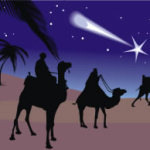
One of the most celebrated and commercialized events of the year, is the season of Christmas. It is purported to be a time of giving, a time of sharing, and a time to celebrate the birth of Jesus Christ. However, if one were to investigate the origin of Christmas , something very interesting would be found: Jesus Christ could not have been born on December 25! Further studies would show that December 25 is a day that was celebrated among pagan, or false god worshippers for many years! This study will answer a few important questions about Christmas and the birth of Christ.
Though the exact date of Jesus’ birth is not known, the Bible gives us enough evidence to determine that it could not have been in December. On the night in which Jesus was born, angels appeared unto shepherds in a field, who were watching over their flock (St. Luke 2:8-14). This could not have occurred in December, because the shepherds in Judea did not abide nor keep their flocks in the fields no later than the fifteenth of October ( Ralph Woodrow; Babylon Mystery Religion p. 160). This was due to the slashing nature of the cold winds and rains ( Alexander Hislop, The Babylons, p. 91). Therefore, there is no way the birth of Jesus occurred on December 25, because there were no shepherds in the fields in December!
Furthermore, the Bible shows that the angel Gabriel appeared unto Mary, the mother of Jesus, in Elul, the sixth month of the Hebrew Calendar (St. Luke 1:26, Neh. 6:15). Since it takes nine months for a child to develop in a mother’s womb (Elisabeth bore John the Baptist nine months after conceiving ! See St. Luke 1:24,36,33,39-40,56-57.), this suggests that Jesus was born in Sivan, the third month of the Hebrew Calendar. This corresponds roughly to May or June on the Gregorian Calendar.
If the birth date of Jesus is not known, why was December 25th chosen?
For more than three centuries, the feast of Christmas was kept on different days throughout the year. In many places, Christmas was celebrated on Epiphany, the sixth day of January, which commemorates the baptism of Jesus, the visit of the Wise Men or Magi to Bethlehem, and the miracle of Cana. December 25 was soon chosen as the date of Christmas by Church authorities because it was a pagan feast to the Unconquered Sun-God (Sol invictus) ( Albert J. Menedez, The December Wars…, p.16). This date was strengthened by the Roman Emperor Aurelian, who had established Christmas on December 25 throughout his empire on A.D. 241, hoping that the feast would unite his large empire. Christmas was further declared a legal holiday throughout the Roman Empire by Emperor Theodosius in his codex of laws in 438 ( Albert J. Menedez, The December Wars…, p.20).
What pagan feasts were celebrated around December 25?
First of all, a pagan is one who worships a false god. Chronos, or Saturn, was a god in Roman mythology, that fled to what is now Italy and ushered in a kind of golden age. A week-long festival called Saturnalia, was held in his honor. This event was a time of revelry, feasting, and gift giving. A religious and secular event, the religious aspects of the feast were observed on the first day of the festival, December 17. Festive customs continued through the last day December 23, in which during this time business was forbidden, and all men, free or slaves, were equal.
Kalends was a midwinter festival that began after Saturnalia, and celebrates the new year. Kept throughout the Roman Empire, this extravagant festival was rowdier than Saturnalia, and banished all that was associated with toil. This was a time in which men were taught not to hold on tightly to money, new consuls were inducted in office, and public buildings were decorated with greenery and lights.
Mithra, was a Sun god in Persian Religion, whose birthday Bramalia has been engrafted into Saturnalia.
How were aspects of pagan festivals transformed to Christianity?
Since these pagan festivals were firmly implanted in society, the Roman Catholic Church found it difficult to persuade the pagans from their customs, so they adopted them. It was in the fifth century that the Roman Catholic Church commanded that Christmas be observed on December 25, day of the birth of Sol (one of the names of the sun god). Though the church originally would have nothing to do with these winter festivals, the Roman Catholic Church under Constantine, began to adopt these pagan festivals with their ceremonies and rites. These relics of paganism were incorporated into Christianity to reconcile heathen converts to Christianity.
So what about pagan origins…Why can’t we give Jesus a birthday?
St. John 1:1-14, states how in the beginning was the Word, the Word was with God, the Word was God, and the Word was made flesh and dwelt among men, which was Jesus. Furthermore, Ephesians 3:9 states that God created all things by Jesus Christ. Therefore, if Jesus was in the beginning, how can we give him a birthday? Besides, if God commanded us to celebrate the birth of Jesus, He would have given us a date or season on which to observe His birth, as He did when He instituted the Feast Days (Leviticus 23). God has strictly stated that we should not add or diminish from what He has commanded us to observe (Deut. 12:32). Furthermore, when we participate in the customs of Christmas, we violate God’s commandment of not serving other gods (Exo. 20:3-5). Christmas is purely a commandment of men and corresponds directly to what Jesus says in St. Mark 7:7 , “Howbeit in vain do they worship me, teaching for doctrines the commandments of men.”
A Brief History of Popular Christmas Customs
Cohen, Henry, and Tristan Potter Coffin. America Celebrates: A Patchwork of Weird and Wonderful Holiday Lore. Detroit:Visible Ink Press, 1991.
Tardo, Russell. The Shocking Truth About Christmas. Faithful Word; P.O. Box 496; Arabi, LA 70032.
Menedez, Albert J. The December Wars:Religious Symbols & Ceremonies in the Public Square. Buffalo:Prometheus Books, 1993.




